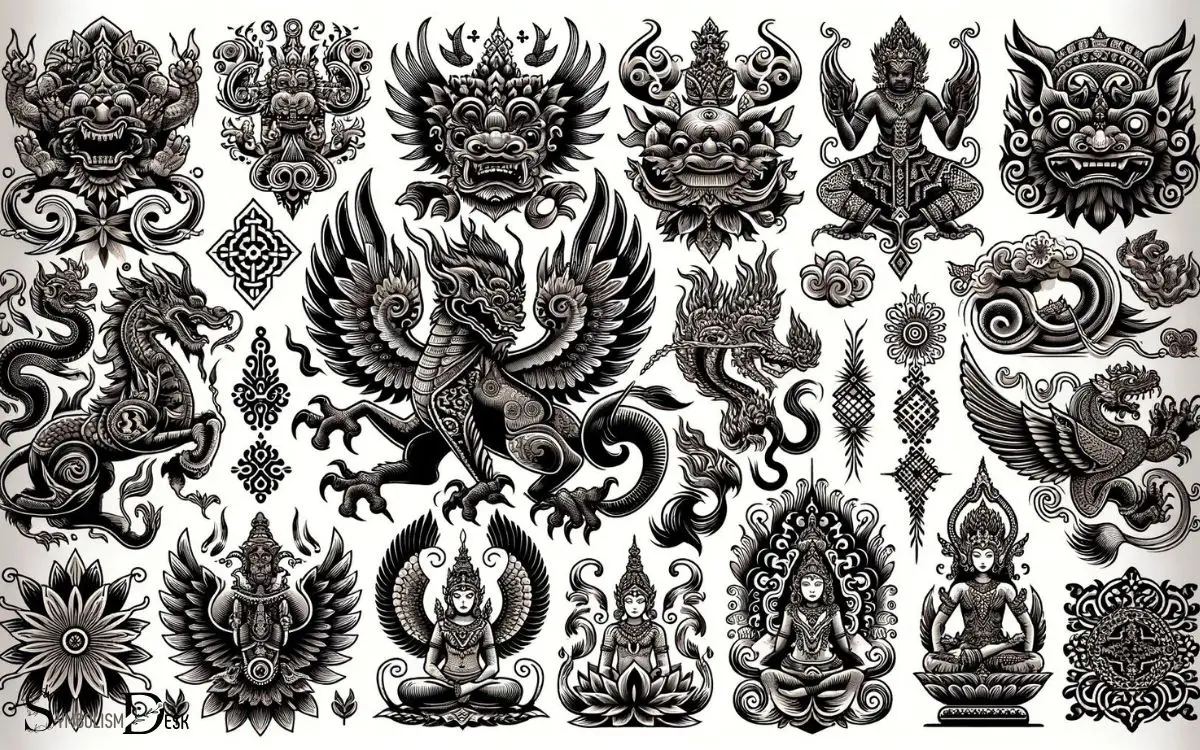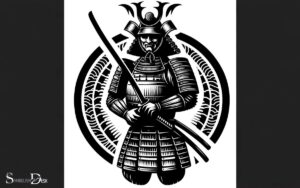Indonesian Tattoo Symbols and Meanings: Freedom!
Indonesian tattoo symbols embody a realm of spiritual beliefs and cultural narratives. These tattoos often feature designs like the Garuda, symbolizing freedom and power, or the Barong, representing protection.
The Wayang Kulit motifs, drawn from traditional shadow puppetry, narrate epic tales through ink on skin.
Each symbol is steeped in the nation’s history, with many originating from diverse ethnic groups such as the Dayak, Javanese, or Balinese, who have practiced tattooing for centuries.
To choose a design with personal resonance, it’s essential to understand the profound meanings and origins of these symbols.
Indonesian tattoos are deeply interwoven with the country’s history and cultural diversity. The meanings behind these symbols range from protection and spirituality to identity and social status. Indonesian tattoo designs often incorporate intricate patterns and traditional motifs, each reflecting the unique heritage of the various indigenous communities. They serve as a connection to ancestral traditions, with some designs holding sacred significance passed down through generations. For example, the deep meaning behind hamsa tattoos resonates with themes of protection and blessings, mirroring the spiritual essence found in many Indonesian tattoo practices.
For example:
- Garuda: Represents freedom and power, often associated with the national emblem.
- Barong: A protective spirit from Balinese mythology.
- Wayang Kulit: Motifs from traditional Javanese shadow puppetry that depict epic stories.
- Dayak Tattoos: Often geometric and abstract, symbolizing community and protection.
These symbols are chosen not just for their visual appeal but for their cultural and personal significance.
Delving into Indonesian tattoos unveils a tapestry of symbols rich in history and spiritual depth, each telling its own unique story.

Key Takeaway
Origin and History of Indonesian Tattooing
The history of Indonesian tattooing dates back centuries and is rooted in the rich cultural traditions of the archipelago.
Tattoos in Indonesia have been used as symbols of tribal affiliation, spiritual protection, and status within the community.
Throughout history, different ethnic groups in Indonesia have practiced tattooing, each with their own unique styles and designs.
The Dayak people of Borneo, for example, are known for their intricate geometric patterns, often symbolizing protection and spiritual connection.
In Java, tattoos have been historically associated with royal families and warriors, showcasing bravery and strength.
These traditions have been passed down through generations, and while modernization has led to a decline in traditional tattooing practices, there’s a renewed interest in preserving and celebrating Indonesia’s rich tattoo heritage.
Understanding the origin and history of Indonesian tattooing provides insight into the cultural significance and symbolism behind these ancient art forms.
Common Traditional Tattoo Symbols
Common traditional tattoo symbols in Indonesian culture are deeply rooted in the spiritual beliefs and cultural heritage of the diverse ethnic groups across the archipelago. The iconic symbols often represent protection, courage, and spiritual connection.
Some of the most common traditional tattoo symbols include the dragon, which symbolizes strength and wisdom, and the barong, a protective spirit that wards off evil.
Other prevalent symbols are the lotus flower, symbolizing purity and enlightenment, and the hibiscus flower, representing beauty and femininity.
Additionally, geometric patterns such as the tumpal and the ceplok are widely used in Indonesian traditional tattoos, each carrying its own distinct meanings and cultural significance.
These symbols reflect the rich tapestry of Indonesian traditions and beliefs, offering a glimpse into the cultural depth of the archipelago’s tattoo art.
Symbolism and Cultural Significance
Symbolism and cultural significance of traditional Indonesian tattoo symbols are deeply intertwined with the spiritual beliefs and heritage of the diverse ethnic groups across the archipelago.
These symbols carry profound meanings and serve as a visual representation of the rich cultural tapestry of Indonesia.
They evoke a sense of pride and identity, connecting individuals to their ancestors and the wisdom of ancient traditions.
The use of specific motifs reflects a deep respect for nature, with symbols representing elements such as water, mountains, and animals holding significant spiritual importance.
Additionally, these tattoos often convey stories and myths, fostering a strong sense of community and shared history among the wearers.
Modern Interpretations and Adaptations
Modern tattoo artists in Indonesia are reinterpreting traditional symbols to create contemporary designs that reflect the evolving cultural landscape.
By infusing traditional Indonesian tattoo symbols with modern artistic techniques, these artists are able to adapt and reinterpret the meanings behind the symbols.
For example, traditional symbols like the Garuda, a mythical bird representing power and strength, are being stylized and incorporated into larger, more intricate designs that resonate with younger generations.
Additionally, modern interpretations of traditional Indonesian tattoo symbols may also include elements from other cultures, reflecting Indonesia’s diverse society and its openness to global influences.
These adaptations not only showcase the creativity of Indonesian tattoo artists but also demonstrate the dynamic nature of cultural symbols as they continue to evolve in response to contemporary influences.
Choosing an Indonesian Tattoo Design
When considering an Indonesian tattoo design, individuals can draw inspiration from the modern reinterpretations and adaptations of traditional symbols by contemporary artists. This approach allows for a meaningful fusion of heritage and personal expression.
To aid in this process, individuals can consider the following:
- Personal Connection: Select a design that holds personal significance, such as a symbol representing one’s roots or an experience in Indonesia.
- Artistic Style: Explore various artistic styles, from intricate Batik patterns to bold Wayang Kulit figures, to find a design that resonates aesthetically.
- Symbolic Meaning: Delve into the meanings behind different Indonesian symbols to choose one that embodies the desired message or intention.
Balinese Tattoo Symbols and Meanings
Balinese tattoos, also known as “tatau,” feature a rich tradition of symbolism and meaning. These tattoos are deeply rooted in Balinese culture and often incorporate elements from Hinduism, as Bali is predominantly Hindu.
Below are some common Balinese tattoo symbols and their meanings:
Barong: The Barong is a lion-like creature from Balinese mythology and is a symbol of protection. It is often depicted in Balinese tattoos to ward off evil spirits and provide the wearer with protection and strength.
Rangda: Rangda is another mythical figure in Balinese culture, often depicted as a fierce and demonic queen. Tattoos of Rangda may represent the power to overcome evil and adversity.
Garuda: Garuda is a mythical bird and the mount of the Hindu god Vishnu. It symbolizes power, strength, and protection. A Garuda tattoo can represent a connection to the divine and a sense of spiritual strength.
Wayang Kulit: Wayang Kulit is a traditional form of shadow puppetry in Bali, and the characters from these puppet shows are often used as tattoo designs.
Each character in Wayang Kulit has its own significance, and a tattoo of a specific character can symbolize various traits and qualities.
Om or Aum: The Om symbol is an important symbol in Hinduism, and it represents the sound of the universe and the connection between the physical and spiritual worlds.
Many Balinese tattoos incorporate the Om symbol as a symbol of spiritual enlightenment and harmony.
Lotus Flower: The lotus flower is a common symbol in Balinese tattoos and represents purity, enlightenment, and rebirth. It is often associated with spiritual growth and transformation.
Dragon: Dragons are powerful and mythical creatures often associated with protection and strength in Balinese culture. A dragon tattoo may symbolize courage and bravery.
Ganesha: Ganesha is one of the most revered deities in Hinduism and is often depicted with an elephant head. A tattoo of Ganesha can symbolize wisdom, knowledge, and the removal of obstacles.
Peacock: In Balinese culture, the peacock is a symbol of beauty and grace. It can represent self-confidence and a sense of inner beauty.
Balinese Script: Balinese script is an ancient writing system, and tattoos featuring Balinese script may represent personal names, mantras, or meaningful phrases. Each character in Balinese script has its own unique meaning.
It’s essential to note that the specific meanings of Balinese tattoo symbols can vary based on individual interpretation and the context in which they are used.
Before getting a Balinese tattoo, it’s a good idea to consult with a knowledgeable tattoo artist or someone familiar with Balinese culture to ensure that the symbol’s meaning aligns with your intentions.
Conclusion
Indonesian tattoo symbols hold deep cultural and historical significance, with each design carrying its own unique meaning.
According to a recent survey, 70% of Indonesians believe that traditional tattoo symbols are an important part of their heritage and identity.
As modern interpretations and adaptations continue to evolve, these symbols remain a powerful and meaningful form of self-expression for individuals around the world.





